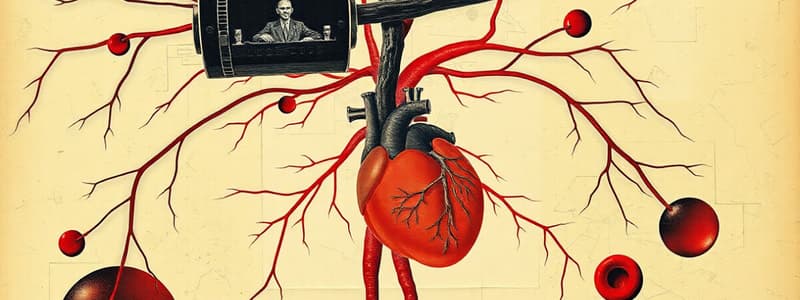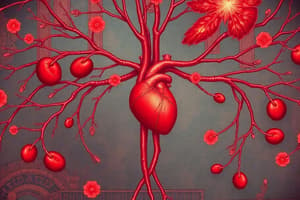Podcast
Questions and Answers
What is the main function of the atrioventricular (AV) valves?
What is the main function of the atrioventricular (AV) valves?
- To separate the right and left atria from each other
- To regulate the openings between the atria and ventricles (correct)
- To control the flow of blood from the ventricles into the arteries
- To maintain pressure in the heart chambers
Which layer of the heart wall is primarily responsible for its muscular contractions?
Which layer of the heart wall is primarily responsible for its muscular contractions?
- Parietal pericardium
- Myocardium (correct)
- Endocardium
- Epicardium
What best describes the pericardial cavity?
What best describes the pericardial cavity?
- An empty space between the heart chambers
- The space between the parietal and visceral pericardium (correct)
- The area where blood circulation starts
- A layer of dense connective tissue surrounding the heart
Which of the following is NOT a chamber of the heart?
Which of the following is NOT a chamber of the heart?
What is the primary purpose of coronary circulation?
What is the primary purpose of coronary circulation?
Where does the coronary sinus empty its collected blood?
Where does the coronary sinus empty its collected blood?
Which of the following valves is responsible for controlling blood flow from the right ventricle?
Which of the following valves is responsible for controlling blood flow from the right ventricle?
Which component ensures that the heart chambers are coordinated with each other during contractions?
Which component ensures that the heart chambers are coordinated with each other during contractions?
What is the primary function of the circulatory system?
What is the primary function of the circulatory system?
Which part of the heart supplies blood to the pulmonary circuit?
Which part of the heart supplies blood to the pulmonary circuit?
What is the largest artery in the body?
What is the largest artery in the body?
Which statement best describes the pericardium?
Which statement best describes the pericardium?
What is the role of the pulmonary veins in the circulatory system?
What is the role of the pulmonary veins in the circulatory system?
Where is the heart located within the human body?
Where is the heart located within the human body?
What do the superior and inferior venae cavae primarily do?
What do the superior and inferior venae cavae primarily do?
How is the heart oriented within the thoracic cavity?
How is the heart oriented within the thoracic cavity?
Flashcards
What is the function of the circulatory system?
What is the function of the circulatory system?
The circulatory system is responsible for transporting substances throughout the body through the blood.
What does the term 'cardiovascular system' refer to?
What does the term 'cardiovascular system' refer to?
The cardiovascular system includes the heart and blood vessels.
What is the pulmonary circuit?
What is the pulmonary circuit?
The pulmonary circuit carries blood to the lungs for gas exchange, then returns it to the heart.
What is the systemic circuit?
What is the systemic circuit?
Signup and view all the flashcards
What is the role of the right side of the heart?
What is the role of the right side of the heart?
Signup and view all the flashcards
What is the role of the left side of the heart?
What is the role of the left side of the heart?
Signup and view all the flashcards
What is the aorta?
What is the aorta?
Signup and view all the flashcards
What are the superior and inferior vena cavae?
What are the superior and inferior vena cavae?
Signup and view all the flashcards
Pericardial Sac
Pericardial Sac
Signup and view all the flashcards
Myocardium
Myocardium
Signup and view all the flashcards
Endocardium
Endocardium
Signup and view all the flashcards
Atria
Atria
Signup and view all the flashcards
Ventricles
Ventricles
Signup and view all the flashcards
Atrioventricular (AV) Valves
Atrioventricular (AV) Valves
Signup and view all the flashcards
Semilunar Valves
Semilunar Valves
Signup and view all the flashcards
Cardiac Conduction System
Cardiac Conduction System
Signup and view all the flashcards
Study Notes
Circulatory System I
- The circulatory system comprises the heart, blood vessels, and blood.
- The cardiovascular system is a component focused on the heart and blood vessels.
- The circulatory system transports substances throughout the body via blood.
- Blood serves as the liquid medium for transporting various materials.
- Blood vessels direct blood flow to specific destinations.
- The heart functions as the pump, maintaining blood flow.
- Without valves, blood flow would require more effort.
Functions of the Circulatory System
- The circulatory system's role involves the heart, blood vessels, and blood.
- The term cardiovascular system specifically refers to the heart and blood vessels.
- The circulatory system is essential for transporting substances to various locations within the body.
The Pulmonary and Systemic Circuits
- The cardiovascular system consists of two main divisions: pulmonary and systemic.
- The pulmonary circuit carries blood to the lungs for gas exchange, then returns it to the heart.
- The systemic circuit circulates blood throughout the body, supplying oxygen and removing waste.
- The systemic circuit includes blood flow to organs and parts of the lungs.
The Pathway of Blood Flow
- Blood flow from the body's right side enters the lungs to gain oxygen.
- The pathway from 4 to 6 is the pulmonary circuit.
- From 9 to 11 is the systemic circuit.
- Violet arrows define deoxygenated blood; orange, oxygenated blood.
The Heart Wall
- The heart wall has three layers: the epicardium (outer layer), myocardium (middle, muscular layer), and endocardium (inner layer).
- The epicardium covers the heart's external surface.
- The myocardium is the muscular center layer.
- The endocardium lines the inner surfaces of the heart's chambers.
The Chambers of the Heart
- The heart possesses four chambers (two atria and two ventricles).
- The right and left atria collect blood returning to the heart.
- The right and left ventricles pump blood out of the heart.
- The superior and inferior vena cavae are primary veins bringing blood to the heart.
The Valves
- The atrioventricular (AV) valves regulate blood flow between the atria and ventricles.
- The right AV valve is also known as the tricuspid valve.
- The left AV valve is also known as the mitral valve.
- Semilunar valves (pulmonary and aortic) regulate blood flow from the ventricles to the arteries.
- The pulmonary valve is between the right ventricle and pulmonary trunk.
- The aortic valve is between the left ventricle and the aorta.
Coronary Circulation
- The coronary arteries supply oxygenated blood to the heart muscle.
- The coronary sinus is a vein that collects blood from the heart muscle.
- Blood from the heart muscle returns blood to the right atrium.
Position, Size, and Shape of the Heart
- The heart lies in the mediastinum, between the lungs, behind the sternum.
- The heart's base is its superior part, where major vessels attach.
- The heart's blunt, pointed end is called the apex.
The Pericardium
- The heart is enclosed in a double-walled sac called the pericardium.
- The outer layer is the pericardial sac and layer of fibrous connective tissue.
- The inner layer of serous tissue is the visceral pericardium, also known as the epicardium.
- The space between the layers is the pericardial cavity filled with serous fluid.
The Conduction System
- The cardiac conduction system controls heart rate and timing.
- The sinoatrial (SA) node acts as the heart's natural pacemaker.
- Atrial and ventricular contraction are coordinated through the conduction system pathways.
- The AV node, AV bundle, and Purkinje fibers relay signals for coordinated contractions.
Studying That Suits You
Use AI to generate personalized quizzes and flashcards to suit your learning preferences.




